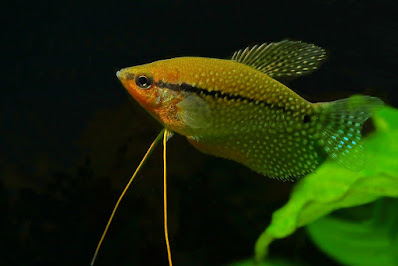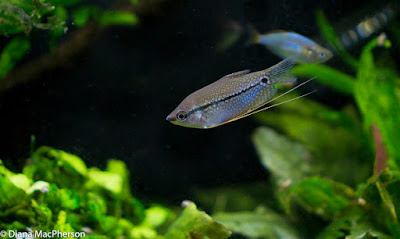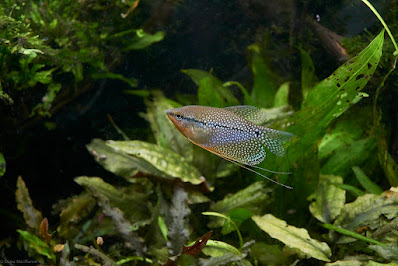Pearl gourami are one of the most popular of the Gouramis species and is frequently kept in aquariums. They are a great community fish and...
Pearl gourami, also know as Lace gourami, Mosaic gourami, Leeri Gourami and its scientific name Trichogaster leeri, are one of the most popular of the Gouramis species and is frequently kept in aquariums. They are a great community fish and do well in planted aquariums.
PEARL GOURAMI - TRICHOPODUS LEERII DESCRIPTION
Pearl gourami is native to the Malay Peninsula (Peninsular Malaysia and southern Thailand), Sumatra, and Borneo. It is found in acidic swamps and streams associated with peat swamp forests, as well as lowland flooded forests.
In nature, this fish lives in stagnant waters, so very calm waters and little oxygen. In order to survive under these conditions, it developed an additional breathing organ - the labyrinth. This organ allows it to breathe air on the surface when necessary.
Trichopodus leerii can grow up to 12 cm long and live for up to 8 years, if kept in the correct conditions. They have a long dorsal fin and beautiful colours with a bright red flash under their gills and mouth and a black line running from their mouth to their tail fin. Their overall colour is mottled white and brown to red spots. Also these fish have unique ventral fins that stretch out as long as their body almost giving the impression of feelers on an insect.
The difference between the male and female can be seen in a few differences. The male has an orange/red throat and beginning of the abdomen, a longer dorsal and anal fin and many “fringes” on his pelvic fin. The female does not have these fringes. The female is usually smaller and thicker. Males become particularly brightly coloured during spawning.
PEARL GOURAMI - TRICHOPODUS LEERII CARE
Pearl gourami is highly recommended to the beginner. It prefers water in the soft to medium range and slightly acidic. It need the minimum tank of 50 gallons for a pair with water temperature of 23-28 °C, pH level of 6.0-7.5 and general hardness of 100-200 ppm.
They are suited more to a dark tank with a lot of plant matter in the tank. Also provide some floating plants under which they can shelter. A filter with a wide outlet where the flow of water disappears fairly quickly is appreciated. They build a bubble nest on the surface of the water, so if the current is too strong, the bubbles will not stick together.
It is a relatively calm and peaceful fish, although males can be aggressive occasionally when defending territory or spawning. Do not keep the pearl gourami with aggressive or very vigorous fish or it will become withdrawn. They can be kept with other gouramis, loaches, danios and larger tetras.
Trichopodus leerii are omnivorous and easy to feed. They will eat basically anything from flake foods to pellets and live foods, such as live worm and live brine shrimp. To avoid deficiencies, it is recommended to vary its power supply. Thus, you can offer live or frozen prey 2 to 3 times a week (cyclops, artemia, daphnia or even bloodworms).
PEARL GOURAMI - TRICHOPODUS LEERII SPAWNING
Males will have a bright red throat and longer fins, which becomes more intense during spawning. Females will be like most female fish are plumper and fuller in the body due to holding eggs, and tend to be less coloured.
They are bubble-nest builders and maintain their eggs and resultant fry in a bubble-nest they construct by blowing bubbles coated in mucous amongst plant material on the water surface. Spawning occurs under the nest in the typical anabantoid embrace. The eggs float upwards and the male shepherds them into the nest. Several more spawnings occur and between 200-300 eggs may be produced.
Once the eggs are laid the female should be removed because the male looks after them. The male then tends to the nest until the eggs hatch, usually in around 20-30 hours. The male continues to maintain the bubble nest until the fry can swim free, about four to five days later. After that, the male should be removed as well.
The fry should be fed infusoria or liquid fry food for the first week, after which they are large enough to accept brine shrimp nauplii, microworm and powdered flake. They grow very slow and care must be exercised when doing water changes as they are very susceptible to changes in water temperature.
BUY PEARL GOURAMI - TRICHOPODUS LEERII AND RELATED PRODUCTS














COMMENTS